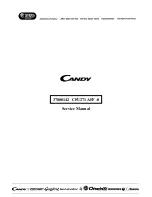
EN -22-
CHAPTER -6: TROUBLESHOOTING
ERROR TYPE
MEANING
WHY
WHAT TO DO
"Low voltage" Warning
This is seen when the
power supply becomes
lower than 170 V.
This not a failure. This prevents any
damage to the compressor. This warning
will clear after the voltage reaches the
required level.
If you are experiencing a problem with your refrigerator, please check the following before contacting the after-sales
service.
Your refrigerator does not operate
Check if:
•
Your fridge is plugged in and switched on
•
The fuse has blown
•
Is the temperature adjustment right?
•
The socket is faulty. To check this, plug another working appliance into the same socket.
Your refrigerator is performing poorly
Check if:
•
The appliance is overloaded
•
The doors are closed properly
•
There is any dust on the condenser
•
There is an adequate distance between the appliance and surrounding walls
If your fridge is operating too loudly;
To maintain the set cooling level, the compressor may be activated from time to time. Noises from your fridge at this
time are normal and due to its function. When the required cooling level is reached, noises will decrease automatically.
If the noises persist;
•
Is your appliance stable? Are the legs adjusted?
•
Is there anything behind your fridge?
•
Are the shelves or dishes on the shelves vibrating? Re-place the shelves and/or dishes if this is the case.
•
Are items placed on your fridge vibrating?
Your refrigerator is operating noisily
The following noises can be heard during normal operation of the appliance.
Cracking (Ice cracking) Noise:
•
During automatic defrosting.
• When the appliance is cooled or warmed (due to expansion of appliance material).
Short cracking:
Heard when the thermostat switches the compressor on/off.
Compressor noise (Normal motor noise):
This noise means that the compressor operates normally. The
compressor may cause more noise for a short time when it is activated.
Bubbling noise and splash:
This noise is caused by the flow of the refrigerant in the tubes of the system.
Water flow noise:
Normal flow noise of water flowing to the evaporation container during defrosting. This noise
can be heard during defrosting.
Air Blowing Noise (Normal fan noise):
This noise can be heard in a No-Frost fridge during normal operation of
the system due to the circulation of air.
There is a build-up of humidity inside the fridge
Check if:
•
All food is packed properly. Containers must be dry before being placed in the fridge.
•
The fridge doors are opened frequently. Humidity of the room will enter the fridge each time the doors are
opened. Humidity increases faster if the doors are opened frequently, especially if the humidity of the room is
high.
•
There is a build-up of water droplets on the rear wall. This is normal after automatic defrosting (in Static Models).
The doors are not opening or closing properly
Check if:
•
There is food or packaging preventing the door from closing
•
The door compartments, shelves and drawers are placed properly
•
The door gaskets are broken or torn
•
Your fridge is level.
If the edges of fridge cabinet that the door joint contact are warm;
Especially in summer (hot weather), the surfaces that the joint contact may get warmer during the operation of the
compressor, this is normal.
Содержание SJ-F1560EVA-EN
Страница 1: ...Home Appliances Fridge freezers SJ F1560EVI EN SJ F1560EVA EN User Manual EN ...
Страница 2: ......
Страница 26: ......
Страница 27: ......
Страница 28: ...Service Support Visit Our Website sharphomeappliances com 52264623 ...





































